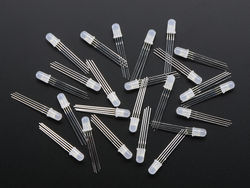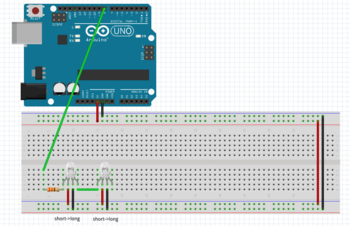RGB LEDs
From Mech
Jump to navigationJump to searchWS2812 Addressable RGB LEDs
(NeoPixels)
Install the NeoPixels Library
- Download ZIP of all library files here
- Unzip the ZIP file when it's done downloading
- Put all of the files from the folder into a new folder called "Adafruit_NeoPixels"
- Put this new folder into your Adruino Libraries folder (usually located at (home folder)/Documents/Arduino/Libraries)
- If you don't have a "Libraries" folder in Arduino/Libraries, create one and put the Adafruit_NeoPixels folder in it
- Restart the Arduino IDE if it's already running
- Open up a new Arduino sketch (program) and check to see if the Adafruit NeoPixels library is installed by going to Sketch-->Import Library and seeing if the NeoPixels library is listed.
Wire Up Your LEDs
- The pinout for one of our RGB LEDs is as shown to the right
- When creating a circuit with RGB LEDs, make sure to have a 300-500 ohm resistor on the data input for the first LED
- Also make sure to connect the ground wire, then the +5V wire
- When disconnecting, disconnect power, then ground
- The next diagram down to the right shows how to wire up two RGB LEDs in a chain to an Arduino Uno.
- The signal for the second LED will travel through the first one.
Writing Code
- This program is a simple test program based on the "simple" example program that comes with the NeoPixels Library.
- If you're using the circuit diagrammed above, this program should make both of your LEDs a moderate green color
#include <Adafruit_NeoPixel.h>
#include <avr/power.h>
// Which pin on the Arduino is connected to the NeoPixels?
// On a Trinket or Gemma we suggest changing this to 1
#define PIN 8
// How many NeoPixels are attached to the Arduino?
#define NUMPIXELS 2
// When we setup the NeoPixel library, we tell it how many pixels, and which pin to use to send signals.
// example for more information on possible values.
Adafruit_NeoPixel pixels = Adafruit_NeoPixel(NUMPIXELS, PIN, NEO_RGB + NEO_KHZ800);
int delayval = 500; // delay for half a second
void setup() {
pixels.begin(); // This initializes the NeoPixel library.
}
void loop() {
// For a set of NeoPixels the first NeoPixel is 0, second is 1, all the way up to the count of pixels minus one.
for(int i=0;i<NUMPIXELS;i++){
// pixels.Color takes RGB values, from 0,0,0 up to 255,255,255
pixels.setPixelColor(i, pixels.Color(0,150,0)); // Moderately bright green color.
pixels.show(); // This sends the updated pixel color to the hardware.
delay(delayval); // Delay for a period of time (in milliseconds).
}
}
- The other examples in the NeoPixels example folder give demonstrations of more complex programs and other displays you can create with the NeoPixels
Applications
- RGB LEDs are great to use as analog "status" lights telling you information such as:
- How much battery something has left
- How much pressure is applied to something
- If it's an appropriate time to trigger some other action


